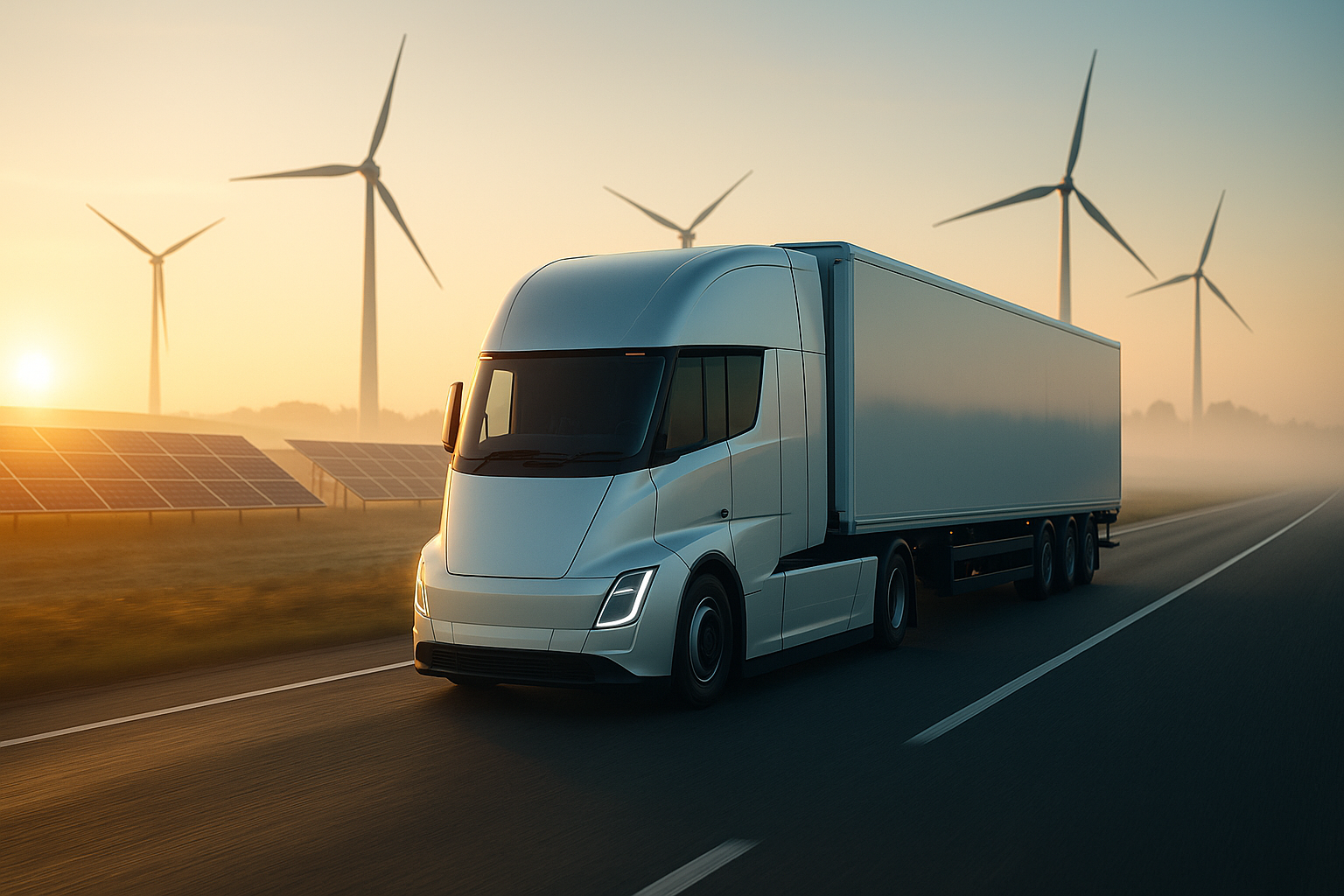Let's Get Straight To The Point
Freight transportation is a major contributor to global greenhouse gas emissions, making sustainability in the sector critical.
Companies can reduce their carbon footprint by adopting eco-friendly vehicles (electric and hydrogen-powered), optimising routes and loads, using alternative fuels (biofuels, LNG, CNG), and leveraging smart technology (telematics, IoT). Partnering with sustainable freight providers, using eco-friendly packaging, and training staff in green practices are also key strategies.
By combining these approaches, businesses can lower emissions while improving efficiency, contributing to a more sustainable future.

The Environmental Impact of Freight
Before diving into how to reduce your carbon footprint, it’s essential to understand the environmental impact of freight. The transportation sector, including freight, is responsible for a significant portion of global greenhouse gas (GHG) emissions. In fact, the freight sector alone accounts for approximately 7-10% of global emissions, with road transportation being one of the most significant contributors.
The Carbon Footprint Of Freight
The carbon footprint of freight primarily comes from the burning of fossil fuels in trucks, ships, trains, and aeroplanes. These modes of transportation emit large amounts of carbon dioxide (CO2), particulate matter, and other pollutants into the atmosphere, contributing to global warming. Therefore, minimising the environmental impact of freight is vital to reducing overall emissions.
Key Strategies for Sustainability in Freight
In order to move toward sustainable freight practices, companies must adopt a combination of technological innovations, operational improvements, and sustainable supply chain strategies. The following sections will break down these strategies in detail.

1. Transitioning To Eco-Friendly Vehicles
A significant contributor to the carbon emissions in the freight industry is the fleet of trucks, ships, and planes that transport goods across the globe. Transitioning to more eco-friendly vehicles is one of the most effective ways to reduce your carbon footprint.
Electric Freight Vehicles
Electric trucks are rapidly becoming a viable alternative to traditional diesel-powered trucks. These vehicles produce zero tailpipe emissions, which significantly reduces their environmental impact. Companies such as Tesla and Rivian are leading the charge in the electric freight vehicle market, and many freight companies are beginning to see the benefits of switching to electric vehicles (EVs).
In addition to the environmental benefits, EVs also offer long-term cost savings. While the upfront cost of purchasing electric trucks may be higher, they require less maintenance, and electricity is generally cheaper than diesel fuel. Over time, these cost savings can offset the initial investment.
Hydrogen-Powered Freight
Another promising technology is the development of hydrogen-powered trucks. Hydrogen fuel cells emit only water vapour as a byproduct, making them a clean alternative to traditional internal combustion engines. While hydrogen infrastructure is still developing, hydrogen-powered freight vehicles can play an essential role in reducing the carbon footprint of long-haul trucking.
2. Optimizing Freight Routes And Loads
One of the simplest ways to reduce emissions is by improving efficiency in freight operations. By optimising routes, adjusting load capacities, and reducing unnecessary mileage, freight companies can significantly reduce their carbon footprint.
Route Optimization
Route optimisation involves using technology to determine the most efficient path for each delivery. This can be done using advanced software tools that factor in variables such as traffic patterns, road conditions, and delivery time constraints. By reducing the amount of time a truck spends on the road, businesses can lower fuel consumption and, consequently, CO2 emissions.
Load Optimization
Another essential aspect of sustainable freight is load optimisation. A full truckload (FTL) is far more energy-efficient than a less-than-truckload (LTL) shipment. By ensuring that trucks are carrying full loads, companies can minimise the number of trips required, reducing fuel consumption and emissions. Additionally, cargo consolidation—combining shipments from multiple customers into a single truckload—can help make better use of available space and reduce the carbon footprint of each delivery.
3. Embracing Alternative Fuels

In addition to switching to electric or hydrogen-powered vehicles, the use of alternative fuels is another key strategy for reducing carbon emissions in freight. Fuels like biofuels, liquefied natural gas (LNG), and compressed natural gas (CNG) produce fewer greenhouse gas emissions than traditional gasoline or diesel.
Biofuels
Biofuels are made from renewable resources such as plants, algae, or waste products. When used in freight vehicles, biofuels can reduce the carbon emissions associated with transportation. This is because biofuels have a smaller carbon footprint compared to conventional fossil fuels, and their production typically generates fewer emissions as well.
LNG and CNG
Both LNG and CNG are cleaner alternatives to diesel. While they are still fossil fuels, they produce fewer harmful pollutants, such as carbon monoxide, nitrogen oxides (NOx), and particulate matter. Trucks powered by LNG or CNG emit less carbon dioxide than their diesel counterparts, making them a practical option for companies seeking to reduce their carbon footprint in freight.
4. Using Smart Technology For Freight Management
Another effective way to reduce carbon emissions is by utilising smart technology in freight management. Technologies like Telematics and the Internet of Things (IoT) sensors allow companies to monitor vehicle performance in real-time and make data-driven decisions that improve fuel efficiency.
Telematics Systems
Telematics involves using GPS and other sensors to track vehicle data, such as fuel consumption, engine performance, and driver behaviour. By using telematics systems, companies can gain valuable insights into how their fleet is operating and identify areas where fuel consumption can be reduced. This can include monitoring driving speed, idling time, and braking habits, all of which impact fuel efficiency and emissions.

IoT Sensors for Predictive Maintenance
IoT sensors embedded in freight vehicles can also play a crucial role in reducing emissions. These sensors can monitor the health of critical components such as engines, tyres, and fuel systems. By predicting when maintenance is needed, companies can avoid breakdowns and ensure that vehicles are running at peak efficiency, reducing the likelihood of excessive emissions due to faulty equipment.
5. Partnering With Sustainable Freight Providers
Sustainability in freight is not only the responsibility of individual companies but can also be achieved through collaboration. Partnering with freight providers who prioritise sustainability can help businesses significantly reduce their carbon footprint.
Choosing Green Freight Partners
When selecting freight partners, it's important to consider their sustainability practices. Look for companies that are committed to reducing their carbon emissions, whether through investments in electric vehicles, renewable energy, or advanced technologies. By choosing sustainable freight providers, you can align your company with partners who share your environmental values, leading to a more sustainable supply chain.
Green Certifications and Standards
Many logistics companies now offer green certifications and adhere to environmental standards, such as the ISO 14001 environmental management standard. These certifications demonstrate a company's commitment to sustainability, and working with such providers ensures that your freight operations are in line with the best environmental practices.
6. Sustainable Packaging And Shipping Practices
Another often overlooked aspect of sustainable freight is the impact of packaging and shipping materials. Reducing waste and improving packaging can make freight more environmentally friendly.
Sustainable Packaging Materials
Switching to eco-friendly packaging materials, such as biodegradable or recyclable options, can reduce waste in the supply chain. Companies can also explore minimalist packaging strategies that reduce the volume of materials used, leading to less waste and lower transportation costs.
Reducing Returns and Waste
An essential element of sustainable freight is ensuring that shipments are accurate and delivered in the best condition possible. Reducing product returns can help lower the carbon footprint associated with freight, as returned goods often require additional shipping, handling, and packaging. By improving product quality, offering better packaging solutions, and using more precise ordering methods, companies can cut down on the need for return shipments.
7. Training Freight Personnel In Sustainable Practices
The human element plays a significant role in achieving sustainability goals. Ensuring that drivers, operators, and other freight personnel are well-trained in sustainable practices can lead to more efficient operations.
Driver Education Programs
Driver behaviour has a direct impact on fuel consumption and emissions. Simple adjustments in driving habits, such as avoiding harsh braking, reducing idling time, and maintaining consistent speeds, can significantly improve fuel efficiency. By offering driver education programs focused on eco-driving, companies can empower their staff to make more sustainable decisions behind the wheel.
Encouraging a Green Culture
Beyond driving habits, fostering a green culture within your company is essential. By creating awareness about sustainability issues and encouraging eco-friendly behaviours across all levels of the organisation, you can drive meaningful change in your freight operations.

Conclusion
Reducing the carbon footprint of freight requires a multi-faceted approach that combines technology, strategy, and collaboration. From transitioning to electric and hydrogen-powered vehicles to optimising freight routes and embracing alternative fuels, there are many practical steps businesses can take to make their freight operations more sustainable.
By adopting green practices such as smart technology, sustainable packaging, and partnering with eco-conscious providers, companies can reduce their environmental impact while improving operational efficiency. Ultimately, sustainability in freight not only helps businesses lower their carbon emissions but also contributes to a healthier planet and a more sustainable future for all.
In a world increasingly focused on climate change, the freight industry must play a key role in the transition to a low-carbon economy. Through innovation, collaboration, and a commitment to sustainability, freight companies can significantly reduce their carbon footprints and lead the charge toward a greener future.
FAQs
Why Is Sustainability Important In The Freight Industry?
Sustainability is crucial because the freight sector contributes around 7-10% of global greenhouse gas emissions. Reducing emissions from freight can help combat climate change and improve air quality, benefiting both businesses and the environment.
How Can Companies Reduce Their Carbon Footprint In Freight?
Companies can reduce their carbon footprint by adopting electric or hydrogen-powered vehicles, optimising routes and loads, using alternative fuels like biofuels and LNG, and utilising smart technologies like telematics and IoT for better fleet management.
What Are Electric Freight Vehicles?
Electric freight vehicles are trucks and other transport vehicles powered by electricity instead of fossil fuels. They produce zero tailpipe emissions, making them a cleaner alternative to traditional diesel-powered vehicles.
What Are Hydrogen-Powered Freight Vehicles?
Hydrogen-powered vehicles use hydrogen fuel cells to generate electricity, emitting only water vapour as a byproduct. They are considered a clean alternative to traditional trucks, especially for long-haul transport.
How Does Route Optimization Help Reduce Emissions?
Route optimisation uses software to find the most efficient delivery paths, reducing travel time and fuel consumption. By cutting down on unnecessary mileage, companies can lower CO2 emissions and improve fuel efficiency.

